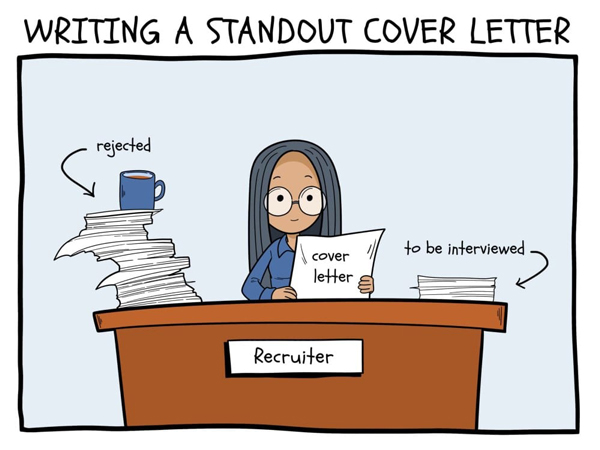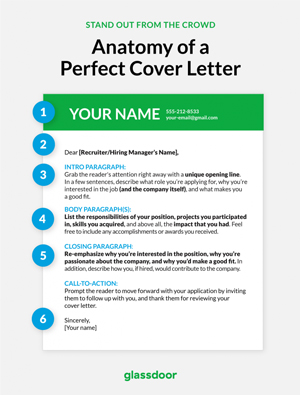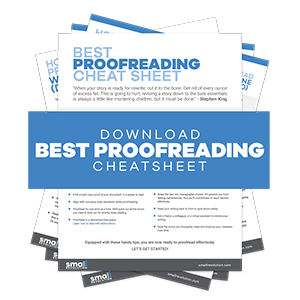As a copywriter, it is fair to assume that the persuasive writing a cover letter requires is right up your alley. There is only one problem with this seeming advantage. Your competition is also great at writing compelling copywriting job applications.
A cover letter is an opportunity to sell yourself well enough to land an interview. Have you been sending out dozens of job applications and not landing interviews? If you already have a strong resume, your copywriting cover letter could be letting you down.
Chances are you are reading this so you can apply to a copywriting job and make a great first impression.
In this article, you will find out the purpose of the cover letter as well as what you should include in it. We will also share tips on how to make your cover letter stand out from the competition.

What’s the Point of a Cover Letter? Pro Tips from Recruiters
Are you applying for copywriting jobs? Great.
Now imagine you are in the shoes of a recruiter or hiring manager. You’ve received over 100 applications and have to fill the position in a month. You begin the first round of elimination using the applicants’ cover letters.
It’s easy to see how you can miss out on a promising job opportunity with a cover letter that’s less than impressive.
Check out this research on some of the key things recruiters look out for in a copywriting cover letter.
Minimum Job Requirements
Every job has a specific skill set required to fulfill the role. The cover letter enables the recruiter to identify these qualifications at a glance.
Include any education and work experience that is relevant to the job advertised.
All too often we see generic cover letters that are not tailored to the role…
Jason Walker (Director at Hays)
Professionalism
Your writing skills are relevant in determining whether you are a suitable candidate.
Keep your tone professional and avoid careless grammar and punctuation mistakes. Observe common protocol with salutations and sign-offs.
Recruiters like to see if you can write with clarity and conciseness. They also look for attention to detail. This includes how well you follow the application guidelines.
Ian Scott, a hiring manager at Randstad Technologies, looks for accuracy in a cover letter. He notes that it is often a true reflection of a candidate’s writing.
Personality
Different organizations have their own unique culture. Recruiters try to find a candidate who is a good cultural fit for a particular company.
How can you express your personality in four paragraphs? Your writing style comes into play here.
Tony Pownall (Regional GM at Hudson) advises candidates to share their personal motivations and experiences. This lets the recruiter know what kind of person they are.
What’s in It for Them?
At the end of the day, the recruiter wants to know- in very few words- what you bring to the table.
Do your career achievements make you a good match for their current needs? Can you solve their specific problems? Prove this with facts and figures.
Guide To Writing a Copywriting Job Cover Letter that Stands Out
Now that you know WHY you need a cover letter, let’s find out what to put in a cover letter for a copywriting job.
1. Contact Information
The recruiter’s first introduction with you is the contact details on your cover letter. These include:
- Official Full Name: Always use the names that appear on your credentials.
- Address: Provide a mailing address including state and zip code if applicable.
- Phone Number: Include your country code in the number e.g., +254700xxxxxxx.
- Email Address: Use an official address, with your initials included.
- Professional Profiles: LinkedIn profile or blog URL (Optional).
Where you put your contact details depends on the cover letter you are writing.
- Hard copy cover letters, or those sent as an attachment, should include contact info at the top. It should also include the recruiter’s contact details.
- If you are emailing your cover letter, add the contact details at the bottom of the letter after you sign off.
2. Catchy Introduction
How you begin your cover letter determines the interest you create for the recruiter. Traditionally, cover letters began with a personal introduction. This was then followed by an expression of interest in the position.
While this is a safe, opening, here are a couple of other copywriting cover letter introduction ideas you can try:
- Open with a joke: With this bold intro, you can poke fun at yourself, relate a funny story or throw in a pun. If you succeed at making the recruiter laugh, they will read the rest of your CV.
- Brag about yourself. State your previous accomplishments in similar roles. This is a powerful way to grab the recruiter’s attention. Include figures if relevant.
- Express your passion. Recruiters like to know what drives you, besides the need for a paycheck. If you have a particular passion for the company’s cause, talk about it.
- Talk about the company to show that you’ve done your research about them. You can open with a recent milestone they achieved and tie it in with your experience.
3. Highlight Your Expertise/Credibility

It is crucial that your cover letter demonstrates you are perfect for the role. That’s why you cannot afford to use the same cover letter for all your applications.
To prove you are a good fit for the job, you can highlight:
- Your educational background
- Your previous work experience
- Your achievements in similar roles
- Special awards or commendations received
4. Create a Personal Connection
What makes you uniquely suited for this position? That’s a question you often come across at interviews. If you want an edge over your competition, you should aim to answer this question in the cover letter.
The easiest way to bond with the recruiter is by telling a story.
Share an authentic story that showcases the personal challenges you have overcome. Tie your accomplishments with your passion for the company’s mission. This is a surefire way to stand out as a candidate.
Another way is to create a personal connection with the company. You do this by identifying some of their challenges and addressing how you can solve them. Special points if you can show evidence of success solving the same kind of challenges.
5. Closing the Sale
Every good thing must come to an end. In the case of cover letters, sooner is always better than later.
As mentioned earlier, the cover letter is your sales pitch for copywriting jobs. The ending needs to be as smooth as the introduction. You can use your closing to:
- Express enthusiasm to progress to the next step of the interview process.
- Summarize the value you bring to the table.
- Thank the recruiter for reviewing your application.
- Offer extra material to strengthen your application e.g., sample articles.
- Sign off professionally.
Create the Perfect Copywriting Resume to Go with Your Cover Letter
Now that you’ve mastered the essentials of writing a cover letter, there’s one more thing you need to double-check.
A winning cover letter needs to go hand in hand with an impressive resume.
If you have had enough of missing out on great job opportunities, sign up now for Small Revolution’s resume writing course. You will learn several tips and tricks to ensure you land more interviews for copywriting jobs.


